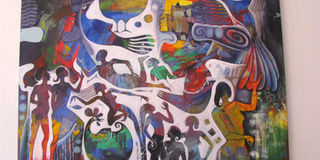Prime
Understanding visual art

Appreciating art is possible if the viewer comes with an open mind. Artists, being human, are not infallible so their opinions may not resonate with everyone.
What you need to know:
Visiting an art gallery is an experience a viewer will find fulfilling, as there are usually many different tones and hues that the artists use to communicate diverse messages.
Appreciating art is fulfilling once you understand what to look out for and how you define it. Artists who have been in the business for a considerable time have described the field as something one grows into.
Even when there are those who might find some aspects of art abstract and difficult to understand, Ugandan artists have come to a point where they can serve a sizeable audience.
“Art is not only about painting; it is also the work of man,” Donald Wasswa, an artist, explains. According to him, an extraordinary way of defining art is by knowing the different types of art. We have the wood sculptures, ceramics and paintings each with coded information the artist wants to share with the viewer.
Unlike in the early 2000s when we only had two or three art spaces, today there are several art studios and art events for example the LABA festival, which gives the viewer a variety of pieces to choose from. Visiting these art galleries and attending these festivals is a primary way of appreciating art.
Just like music where the listener probably may not appreciate a song on its debut, art needs time for the viewer to fully appreciate it, according to Dominic Muwanguzi, an art critic and historian. “In each art piece the artists wants the viewer to meditate and find his own interpretation of his work,” says Muwanguzi.
Positive thoughts
According to Collin Sekajugo, founder of Weaver Bird Arts Community, appreciation of art is possible only if the viewer thinks positive about the message the artist is relaying and thinks of it as a discipline. Sekajugo says art should not be considered foreign; it is all about us and our culture.
“Whenever you go to an art space, start with the small things. Just connect art with reality because we artists just draw feeling from our society,” Paul Ndema suggests.
Knowing the artist showing at a particular art space is also important because appreciation of his work comes with his character. Once you are aware of his being and behaviour, you will leave an exhibition with satisfaction.
There are three important rooms in any gallery that a visitor should not miss; the washrooms, the café and the gift shop. Most galleries hung great masters above the urinals. They would have more chance of being looked at properly than anywhere else.
When you have failed to be moved by any of the great masters in the galleries, a nice cup of tea and a slice of cake will give you that missing sense of spiritual uplift.
In the gift shop, you can buy postcards of the great masters, so you can actually have a good look at them without being jostled by other visitors. You can also buy posters to hang up at home. It is a sign you appreciate the artists’ work.




